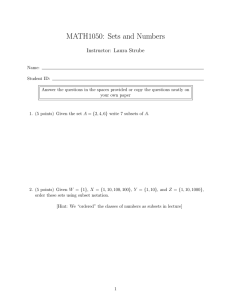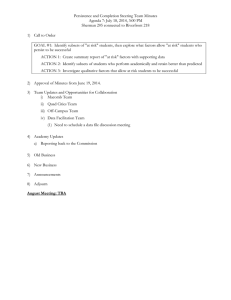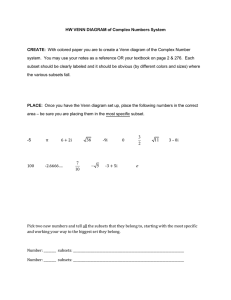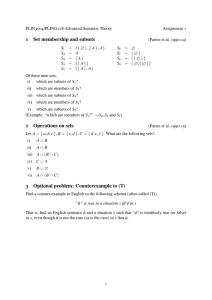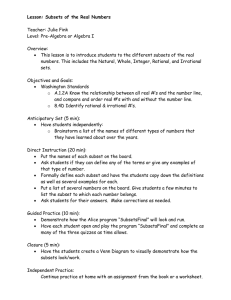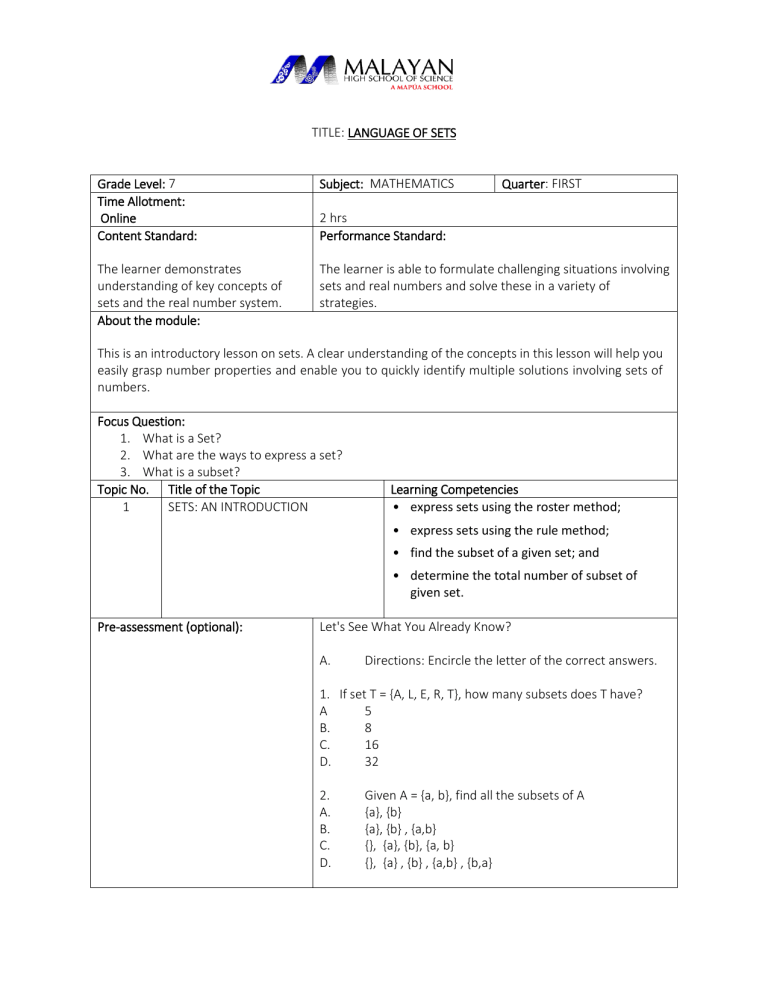
TITLE: LANGUAGE OF SETS
Grade Level: 7
Time Allotment:
Online
Content Standard:
Subject: MATHEMATICS
Quarter: FIRST
The learner demonstrates
understanding of key concepts of
sets and the real number system.
About the module:
The learner is able to formulate challenging situations involving
sets and real numbers and solve these in a variety of
strategies.
2 hrs
Performance Standard:
This is an introductory lesson on sets. A clear understanding of the concepts in this lesson will help you
easily grasp number properties and enable you to quickly identify multiple solutions involving sets of
numbers.
Focus Question:
1. What is a Set?
2. What are the ways to express a set?
3. What is a subset?
Topic No. Title of the Topic
1
SETS: AN INTRODUCTION
Learning Competencies
• express sets using the roster method;
• express sets using the rule method;
• find the subset of a given set; and
• determine the total number of subset of
given set.
Pre-assessment (optional):
Let's See What You Already Know?
A.
Directions: Encircle the letter of the correct answers.
1. If set T = {A, L, E, R, T}, how many subsets does T have?
A
5
B.
8
C.
16
D.
32
2.
A.
B.
C.
D.
Given A = {a, b}, find all the subsets of A
{a}, {b}
{a}, {b} , {a,b}
{}, {a}, {b}, {a, b}
{}, {a} , {b} , {a,b} , {b,a}
3.
A.
B.
C.
D
If C = {s,h} and D = {e, a, r, s} , what is C D?
{s}
{h,e,a,r,t}
{s,h,a,r,e}
{s.h,a, r,e,s}
4.
A
B.
C.
D.
If A= {l,o,v,e,y} and B= {w,o, l, v, e, s}, what is A ∩ B?
{}
{l,o,v,e}
{l,o,v,e, y, w, s}
{Lo.v,e, y, w, 0, I, v, e, s}
5.
A
B.
C.
D.
If A= {A, L, I,V,E} and B= {A,C, T}, then what is A-B?
{L,I,V,E}
{A, C, T}
{A}
{A, L, I, V,E, C, T}
6.
Suppose U = {O, 1, 2, 3, 4, 5, 6, 7, 8} and E = {2, 4, 6, 8},
what is the complement of Set E?
A
{O,1, 3, 5, 7}
B.
{I, 3, 5, 7}
C.
{2,4, 6, 8}
D.
{O, 1,2, 3, 4, 5, 6, 7, 8}
7.
How can you express a set whose elements are b, e, s,
t in roster form?
A
{b, e, s, t}
B.
{b, e, s, t, s}
C.
{x/x is a letter in the alphabet}
D.
{x/x is a letter from the word best}
8.
How can you express a set whose elements are
numbers greater than 5 in roster form?
A.
{5, 6, 7, }
B.
{6, 7, 8, }
C.
{x|x is a number greater than 5}
D.
{x|x is a number greater than or equal to 5}
9.
How can you express a set whose elements are a, e, i,
0 and u in rule form?
A.
{a, e , i, 0, u}
B.
{a, b, c, d, e, ... y, z}
C.
{xix is a vowel}
D.
{xix is a consonant}
10.
How can you express a set whose elements are 5,6,7,8
... in rule form.
A.
B.
C.
D.
{5,6,7,8 ... }
{6, 7, 8 ... }
{ x|x is a number greater than 4}
{ x|x is a number greater than 5}
B.
1.
2.
3.
Identify the given sets whether equal or equivalent:
A= {I, 2, 3},
B= {4, 5, 6}
C= {m, i,1,e, s} D= {s, m, i, 1,e,}
D= {*,O,*}
E={O,O,A}
C. A survey of 40 persons shows that 21 preferred to eat
spaghetti, 24 preferred to eat palabok and 15 preferred to eat
both. Make a Venn diagram then answer the following
questions.
Resources:
1.
How many persons eat spaghetti only?
2.
How many persons eat palabok only?
3.
How many persons do not eat both spaghetti and
palabok?
https://lrmds.deped.gov.ph/
http://amsi.org.au/teacher_modules/pdfs/Sets_and_venn_di
agrams.pdf
Learning Activities
Explore:
Let’s Study and Analyze!
Study the dialogue below:
Angelic Joy was assigned to report about collection. During her report she asked her
classmates, "What do you collect?" Tetchie said. "I collect shells on the sea shore." Vicky said, "I
love to collect paintings." Danny said, "I collect toy cars." Jenny said, "I collect ribbons." Robert said"
1collect stones."
If you are one of the students of that class, how will you respond to the question, "What do
you collect?"
Your answers could be one of the following:
Shoes, bags, slippers, gems, paintings, toys, bears, wallets, books, different currency, cards,
scarves, matches, etc. The collections of different sorts of things may be called a set, for example,
a set of shoes, a set of bags, etc ...
A set is a collection of well-defined distinct objects or things. A set is said to be welldefined if it is possible to determine whether the objects or things belong to a given set.
Distinct means that elements should not be repeated. The objects or things are called
elements of a set. We use ∈ to denote an element of the set and ∉ to denote not an element
of the set.
Normally, sets are denoted by capital letters. Here are some examples of sets.
EXAMPLE 1
A= {1,2,3,4,5}
B= {1,3,5,... }
C = { l, o, v, e }
D = { c, a, r, e }
E = { b, e, a, u, t, y }
F = {x|x (this is read as set of x such that x) is a positive number less than
6}
G = {x|x is a letter from the alphabet}
H = {x|x is a number greater than 8}
There are two ways of describing a set. One way of describing set is by listing it down known as the
listing or roster method. There are times that in order to describe a set, the elements of the set may be
characterized or described. You call this method as the rule method.
In the previous example, how do you describe A, B, C, D and E? How about F, G, and H?
___________________________________________________________________________________
___________________________________________________________________________________
___________________________________________________________________________________
_________
Compare your answer with mine.
A, B, C, D and E are sets described using the roster method.
F, G and H are sets described using the rule method.
Set A whose elements are 3 and 4 can be expressed in roster form as A= {3, 4}.
How can you express set B whose elements are c, u, t and e? _______________
Compare your answer with mine. B = {c, u, t, e}
Set C whose elements are numbers greater than 7 are expressed in roster form.
C= {8, 9, 10, 11, 12, ...} Here, the three dots means that it will continue.
How can you express set C whose elements are numbers greater than 20?
_____________________________________________________
How can you express set D whose elements are numbers less than 15?
_____________________________________________________
Compare your answer with mine.
Possible answers:
C = {21, 22, 23, 24, 25, …}
D = {14, 13, 12, 11, 10, …}
Set F is a set whose elements are numbers between 15 and 20 and is expressed in roster form as F =
{16, 17, 18, 19 }.
How can you express set G whose elements are numbers between 30 and 40?
___________________________________________________________________
Compare your answer with mine.
G = {31, 32, 33, 34, 35, 36, 37, 38, 39,}
Sets can be described using the rule method. Thus, if you have H = {I, 2, 3, 4, 5, 6} you can express it in
rule form as H = {x|x is a number from 1 to 6}. Here, x|x is read as "x such that x."
How can you express the following in rule form:
1.
I = {1, 2, 3, 4, 5, 6, 7, 8, 9, 10} ________________________________
2.
J ={F,I,R, S,T}
________________________________
3.
K = {10, 11, 12, 13}
________________________________
4.
L = {13, 14, 15}
________________________________
5.
M= {20, 19, 18}
________________________________
Compare your answer with mine
1.
2.
3.
4.
5.
I = {x/x is a number from 1 to 10}
J = {x/x is a letter from the word FIRST}
K = { x/x are numbers between 9 to 14 }
L= {x/x is a number greater than 12}
M = { x/x is a number less than 21 }
Let us consider the following definitions which will be very useful in the succeeding
discussions.
Definition 1. A null set or empty set is a set with no element or elements in it. It is denoted by
{ } or ∅
Definition 2. A subset is a set which contains an element or elements of another set.
Definition 3. { } or the set itself is considered as improper subset. It is denoted by ⊆
Definition 4. Proper subsets are subsets which contain an element or elements less than the
elements of another set.
Look at the examples below.
A= {1}
Subsets: { } and {1}
Improper subsets: { } and {1}
Proper subsets: none
Total number of subsets: 2
B= {1, 2}
Subsets: { }, {1}, {2}, {1, 2}
Improper subsets: { } and {1, 2}
Proper subsets: {1}
and {2}
Total number of subsets: 4
C= {1, 2, 3}
Subsets: { }, { 1 }, {2 }, { 3 }, { 1,2 }, { 1,3 } {2, 3 } { 1,2, 3}
Improper subsets: { } and {1, 2, 3}
Proper subsets: { 1 }, { 2 }, { 3 }, { 1, 2 }, { 1, 3 }, { 2, 3 }
Total number of subsets: 8
Try this: D= {1, 2, 3, 4}
1. What are the subsets of D?
_____________________________________________
2. What are the improper subsets of D?
_____________________________________
3. What are the proper subsets of D?
_______________________________________
4. What is the total number of subsets?
_____________________________________
Compare your answer with mine:
Given: D= {1, 2, 3, 4}
Subsets: { } { 1}, {2}, {3}, {4}, { 1 ,2 } {1,3 }, {I, 4 }, { 2, 3 },
{ 2, 4 }, { 3,4 }, { 1,2,3}, {I, 2, 4 }, {I, 3, 4}, {2,3, 4 }, { 1,2,3,4 }
Improper subsets: { } and {1, 2, 3, 4}
Proper subsets: { 1 }, { 2 }, { 3 }, { 4 }, { 1, 2 }, { 1, 3 } , { 1, 4 },
{2,3}, {2,4}, {3,4}, {1,2,3}, {1,2,4}, {1,3,4}, { 2, 3,4}
Total number of subsets: 16
If E=
{1,2,3,4,5}
1. What are the subsets of E?
_________________________________________________________________
2. What are the improper subsets of E?
_________________________________________________________________
3. What are the proper subsets ofE?
_________________________________________________________________
4. What is the total number of subsets?
_________________________________________________________________
Compare your answer with mine.
Given: E= {1, 2, 3, 4, 5}
Subsets:{ }, { 1 }, { 2 }, { 3 }, { 4 }, { 5 }, { 1, 2 }, { 1, 3 }, { 1, 4 },
{ 1,5 }, {2, 3 }, {2, 4 }, {2, 5 }, {3,4 }, {3, 5 } {4,5 },
{1,2,3 }, { 1,2,4 }, { 1,2,5 }, { 1,3,4 }, { 1,3,5 }, { 1,4,5 }, { 2, 3,4 },
{ 2, 3, 5 }, { 2,4,5 }, { 3,4,5 }, { 1,2,3,4 }, { 1,2,3,5 }, { 1,2,4,5 },
{ 1, 3,4, 5, }, {2, 3,4, 5 }, { 1, 2, 3, 4, 5 }
Improper subsets:{ } and { 1,2,3,4,5}
Proper subsets: { 1 }, { 2}, { 3 }, { 4 }, { 5 }, { 1,2 }, { 1,3 },
{ 1,4 }, { 1,5 }, { 2, 3 }, {2, 4 }, {2, 5 }, { 3,4 }, {3,5}, { 4,5},
{ 1,2,3 }, { 1, 2,4 }, { 1,2,5 }, { 1,3,4 }, {I, 3, 5 }, { 1,4,5 },
{2,3,4}, {2,3,5}, {2,4,5}, {3,4,5}, {1,2,3,4}, {1,2,3,5},
{ 1,2,4,5 }, { 1,3,4,5 }, {2, 3, 4, 5 }
Total number of subsets: 32
Can you find a rule which will give the total number of subsets given the total number
of elements of a given set?
Recall that,
If you have 1 element, you have 2 subsets.
If you have 2 elements, you have 4 subsets.
If you have 3 elements, you have 8 subsets.
If you have 4 elements, you have 16 subsets.
If you have 5 elements, you have 32 subsets.
You will notice that the total number of subsets is always a multiple of 2. Similarly, if 2 is
raised to the number of the elements, you will get the number of subsets. In notation, the
total number of subsets is equal to 2n where n is the total number of elements of the given
set.
Hence,
If n=l,
21 = 2
If n=2,
22 = 2 x 2 = 4
If n=3,
23= 2 x 2 x 2= 8
If n=4,
24 =2 x 2 x 2 x 2 = 16
If n=5,
25= 2 x 2 x 2 x 2 x 2 = 32
These all agree with what we have before.
If you have 6 elements in a set, how many subsets are there? ___________
If you have 7 elements in a set, how many subsets are there? ___________
Compare your answers with mine:
If you have 6 elements, there are 26 or 64 subsets.
If you have 7 elements, there are 27 or 128 subsets.
In a Nutshell…
• A set is a collection of well-defined distinct objects or things.
• Elements are objects or things in a set.
• You denote sets by using capital letters.
• A null set or empty set is a set with no element.
• Sets can be described using the roster or listing
method or using the rule method.
• When you describe sets by listing or roster
method, you list down the elements of the given sets.
•
When you describe using the rule method, you
describe the characteristic of the given set
•
A subset is a set which contains at least one
element of the given set.
• A subset can be a proper subset or an improper subset.
•
{ } and the set itself are improper subsets. The
rest are proper subsets.
•
The total number of subsets is obtained using the
formula, total number of subsets = 2n where n is the
total number of elements in the given set.
QUIZ NO. 1
A.
B.
Express the following in roster method:
1.
The set whose members are 10, 20, 30 and 40.
2.
The set whose members are S, E and T.
3.
The set whose members are numbers between 25 and 30.
4.
The set whose members are numbers less than 30.
5.
The set whose members are numbers greater than 15.
Express the following in the rule method:
1.
{L, I,F,E }
2.
{D,A,R,L,I,N,G }
3.
{30, 31, 32, 33, ... }
4.
{ 10, 12, 14, 16, ... }
5.
{ 6, 9, 12, ... }
C.
True or False:
1. 0= {}
D.
E.
2.
{ 0 } is an empty set.
3.
Null set is a proper subset.
4.
The set is an improper subset.
5.
If A = { T, Y }, then there are 4 subsets.
List down all the possible subsets of the following:
1.
A = { love, care, respect}
2.
B = { do, re, mi, fa, so }
3.
C = { USA, RP, USSR, HK }
Compute the total number of subsets of the following sets given the
number of elements.
1
D={J,K,L,M,N,0, P,Q,R,S}
2.
E = { 2, 4, 6,8, 10, 12, 14, 16, 18,20,22,24 }
3.
F = { I, II, III, IV, V, VI, VII, VIII }
Firm-Up
Deepening
Performance Task with Rubrics (See attached file. Due on Friday of Week 2)
Synthesis or Assignment:
I am most confused about…
________________________________________________________
________________________________________________________
________________________________________________________
________________________________________________________
________________________________________________________
________________________________________________________
________________________________________________________
_________________________________________.
Prepared by:
Mr. John P. Lagrazon
Faculty, MaSciTech Department
MHSS
Grade 7
Performance Task # 1 (Set Language)
POP OR FLOP?
Direction: Conduct a survey among your classmates on a particular category and reflect the results of the survey on
a Venn diagram
Steps:
1. Choose a category.
For example: Membership in social media sites, preferred computer games or favorite music bands.
2. Identify 3 representative of that category and ask your classmates to choose one from them.
For example: Which among these social media sites do you use or visit?
a. Facebook
b. Twitter
c. Instagram
3. Present results of the survey in a Venn diagram. You may use a PowerPoint presentation and or visual arts
of your choice.
4. Write 5 questions about the Venn diagram for your classmates to answer.
RUBRIC
Performance Task # 1 (Set Language)
POP OR FLOP?
Category
Diagrams and
Sketches
Mathematical
Errors
Above
Standards (4)
Diagrams and/or
sketches are clear and
greatly add to the
reader's
understanding of the
procedure(s).
90-100% of the steps
and solutions have no
mathematical errors.
Mathematical
Concepts
Explanation shows
complete
understanding of the
mathematical
concepts used to solve
the problem(s).
Working with
Others
Student was an
engaged partner,
listening to
suggestions of others
and working
cooperatively
throughout lesson.
All problems are
completed.
Completion
Meets Standards
(3)
Diagrams and/or
sketches are
clear and easy to
understand.
Approaching
Standards (2)
Diagrams and/or
sketches are
somewhat difficult
to understand.
Below
Standards (1)
Diagrams and/or
sketches are difficult to
understand or are not
used.
Almost all (8589%) of the
steps and
solutions have
no mathematical
errors.
Explanation
shows
substantial
understanding of
the
mathematical
concepts used to
solve the
problem(s).
Student was an
engaged partner
but had trouble
listening to
others and/or
working
cooperatively.
All but one of
the problems are
completed.
Most (75-84%) of
the steps and
solutions have no
mathematical
errors.
More than 75% of the
steps and solutions
have mathematical
errors.
Explanation shows
some
understanding of
the mathematical
concepts needed
to solve the
problem(s).
Explanation shows very
limited understanding
of the underlying
concepts needed to
solve the problem(s)
OR is not written.
Student
cooperated with
others, but needed
prompting to stay
on-task.
Student did not work
effectively with others.
All but two of the
problems are
completed.
Several of the problems
are not completed.
Total
Score


